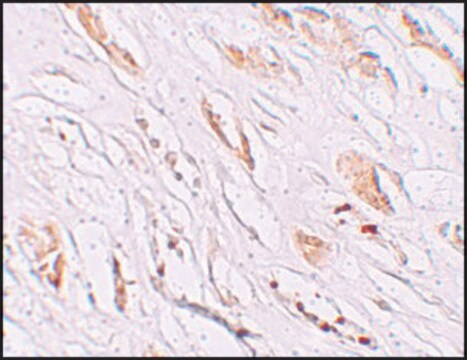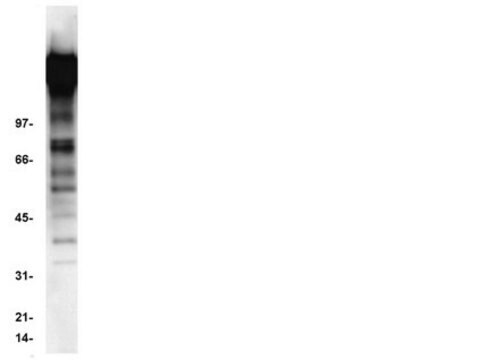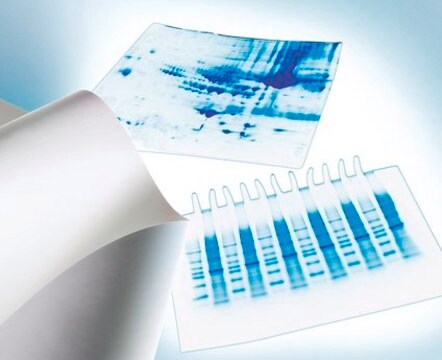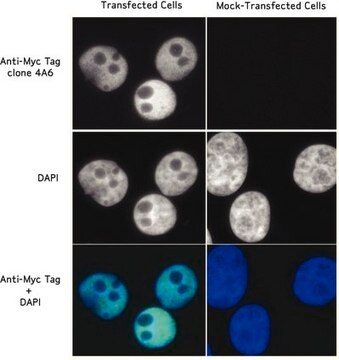おすすめの製品
結合体
FITC conjugate
品質水準
抗体製品の状態
purified from hybridoma cell culture
抗体製品タイプ
primary antibodies
クローン
7A9-3A3, monoclonal
形状
buffered aqueous solution
保管条件
protect from light
濃度
~1.0 mg/mL
テクニック
immunofluorescence: 1:200-1:400 using human HEK-293T cells over-expressing CAS9 protein
アイソタイプ
IgG1
UniProtアクセッション番号
輸送温度
dry ice
保管温度
−20°C
ターゲットの翻訳後修飾
unmodified
詳細
CRISPR (Clustered Regularly Interspaced Short Palindromic Repeats) belongs to the type II CRISPR/CAS9 system. It is part of an adaptive immune system of the Streptococcus pyogenes SF370, protecting from pathogens′ target genes by cleaving the foreign DNA in a sequence-dependent manner.
The type II CRISPR/Cas system has been adapted to expression in eukaryotic cells. The Cas9 endonuclease can be engineered with a single gRNA (guide RNA), directing a DNA double-strand break (DSB) at a desired genomic location. As a result, the cell activates endogenous DNA repair processes, either non-homologous end joining (NHEJ) or homology-directed repair (HDR). In comparison to other genome-editing technologies such as designer zinc fingers (ZFs), transcription activator–like effectors (TALEs) and homing meganucleases, the CRISPR/CAS9 system is a scalable, affordable and easy to engineer. Therefore, the anti-CRISPR/CAS9-FITC conjugated antibody can be a useful tool for detecting CRISPR/CAS9 positively transfected cells, revealing DSB sites in their genome.
The type II CRISPR/Cas system has been adapted to expression in eukaryotic cells. The Cas9 endonuclease can be engineered with a single gRNA (guide RNA), directing a DNA double-strand break (DSB) at a desired genomic location. As a result, the cell activates endogenous DNA repair processes, either non-homologous end joining (NHEJ) or homology-directed repair (HDR). In comparison to other genome-editing technologies such as designer zinc fingers (ZFs), transcription activator–like effectors (TALEs) and homing meganucleases, the CRISPR/CAS9 system is a scalable, affordable and easy to engineer. Therefore, the anti-CRISPR/CAS9-FITC conjugated antibody can be a useful tool for detecting CRISPR/CAS9 positively transfected cells, revealing DSB sites in their genome.
免疫原
Recombinant protein within the N-terminal region of Streptococcus pyogene Cas9
アプリケーション
Monoclonal Anti-CRISPR/CAS9-FITC recognizes the CAS9 protein in CAS9 construct over-expression systems. The antibody may be used in various immunochemical techniques including Immunofluorescence. The antibody successfully recognizes mutant Cas9 variants, including nickase Cas9 and dead Cas9 (dCas9) and does not cross react with FnCas9 from Francisella novicida bacteria and Cpf1 proteins from Acidaminococcus sp. (strain BV3L6) and Lachnospiraceae bacterium ND2006.
物理的形状
Solution in 0.01M phosphate buffered saline pH 7.4 containing 1% bovine serum albumin and 15mM sodium azide.
保管および安定性
For continuous use, store at 2-8°C, protected from light for up to one month. For extended storage, freeze in working aliquots. Repeated freezing and thawing is not recommended. If slight turbidity occurs upon prolonged storage, clarify the solution by centrifugation before use. Working dilution samples should be discarded if not used within 12 hours.
その他情報
This product is for R&D use only, not for drug, household, or other uses.
In order to obtain best results in different techniques and preparations we recommend determining optimal working concentration by titration test.
In order to obtain best results in different techniques and preparations we recommend determining optimal working concentration by titration test.
適切な製品が見つかりませんか。
製品選択ツール.をお試しください
保管分類コード
10 - Combustible liquids
引火点(°F)
Not applicable
引火点(℃)
Not applicable
適用法令
試験研究用途を考慮した関連法令を主に挙げております。化学物質以外については、一部の情報のみ提供しています。 製品を安全かつ合法的に使用することは、使用者の義務です。最新情報により修正される場合があります。WEBの反映には時間を要することがあるため、適宜SDSをご参照ください。
Jan Code
SAB4200735-VAR:
SAB4200735-100UL:
SAB4200735-BULK:
試験成績書(COA)
製品のロット番号・バッチ番号を入力して、試験成績書(COA) を検索できます。ロット番号・バッチ番号は、製品ラベルに「Lot」または「Batch」に続いて記載されています。
Patrick D Hsu et al.
Cell, 157(6), 1262-1278 (2014-06-07)
Recent advances in genome engineering technologies based on the CRISPR-associated RNA-guided endonuclease Cas9 are enabling the systematic interrogation of mammalian genome function. Analogous to the search function in modern word processors, Cas9 can be guided to specific locations within complex
Luisa Bortesi et al.
Biotechnology advances, 33(1), 41-52 (2014-12-24)
Targeted genome editing using artificial nucleases has the potential to accelerate basic research as well as plant breeding by providing the means to modify genomes rapidly in a precise and predictable manner. Here we describe the clustered regularly interspaced short
Luciano A Marraffini et al.
Nature, 463(7280), 568-571 (2010-01-15)
All immune systems must distinguish self from non-self to repel invaders without inducing autoimmunity. Clustered, regularly interspaced, short palindromic repeat (CRISPR) loci protect bacteria and archaea from invasion by phage and plasmid DNA through a genetic interference pathway. CRISPR loci
Elitza Deltcheva et al.
Nature, 471(7340), 602-607 (2011-04-02)
CRISPR/Cas systems constitute a widespread class of immunity systems that protect bacteria and archaea against phages and plasmids, and commonly use repeat/spacer-derived short crRNAs to silence foreign nucleic acids in a sequence-specific manner. Although the maturation of crRNAs represents a
Martin Jinek et al.
eLife, 2, e00471-e00471 (2013-02-07)
Type II CRISPR immune systems in bacteria use a dual RNA-guided DNA endonuclease, Cas9, to cleave foreign DNA at specific sites. We show here that Cas9 assembles with hybrid guide RNAs in human cells and can induce the formation of
ライフサイエンス、有機合成、材料科学、クロマトグラフィー、分析など、あらゆる分野の研究に経験のあるメンバーがおります。.
製品に関するお問い合わせはこちら(テクニカルサービス)







